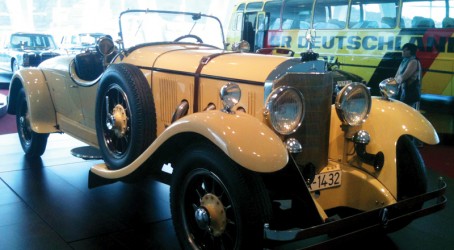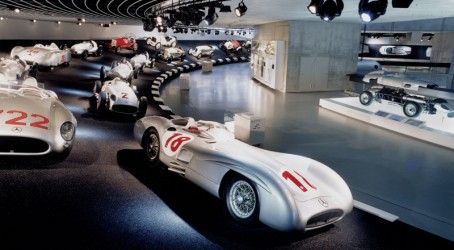Museums
No companies do self-worship quite like the German carmakers. BMW, Porsche and Mercedes-Benz all have monumental museums highlighting their illustrious pasts. There’s nothing wrong with a bit of flagrant narcissism, especially when you have as much to say as these firms undoubtedly do.
The Mercedes-Benz Museum in Stuttgart is a particular delight, looking as good from the outside as it does on the inside. The eye-catching building is inspired by the double-helix structure of the DNA spiral that carries the human genome. Its distinctive shape serves its purpose rather well – visitors take an elevator up nine levels and then wander down gently sloping floors in a circular direction, passing more than 160 cars on the way.
The museum offers a chronological journey through Mercedes-Benz’s history, starting as far back as 1886. The progression of time gives clear insight into the development of automotive engineering, from the first diesels and superchargers, all the way through to emission-free motoring using fuel cells. Side exhibitions recognise the role of the engineer, with Fascination of Technology displays guiding the visitor through the concept, design and assembly process of the modern vehicle.
But it’s the vehicles themselves that really steal the show. Mercedes-Benz has produced so many inspirational cars during its long history that the visitor is truly spoilt for choice. As a lover of classic cars, my head was turned by several curvaceous beauties from the early-to-mid part of the 20th century, rather than the more sharply angled supercars of today. But that was just a matter of personal choice – there’s plenty to see from every era.
An early statement of intent was the 1926 24/100/140 PS Roadster, a substantial two-seater with a supercharged engine. The car on display in the museum was bought by Oscar Henschel, who was the head of the locomotive, commercial vehicle and later aircraft manufacturer Henschel & Son in Kassel. It was a car that truly portrayed his wealth and status.


Then there is the 1952 Mercedes-Benz 300, a gorgeous example from the post-war period, and a vehicle that quickly became the most important status car of the young Federal Republic. It was a combination of form and function, featuring a six-cylinder engine producing 115hp, and with a top speed of 100mph. Fewer than 5,000 Mercedes-Benz 300s were built, and a model in decent condition today would set a collector back tens of thousands of euros.
Then a couple of years later came the 1955 300 SLR “Uhlenhaut coupe”, a hardtop version of the 300 SLR racing car developed for the 1956 motorsport season. It was never used in racing, though, because the company ceased motorsport activity at the end of the 1955 season. Instead the 300 SLR coupe served Rudolf Uhlenhaut, the head of the test department, as a company car. Lucky Rudolf: the gull-wing coupe was the epitome of sophisticated cool, yet it boasted a ferocious eight-cylinder engine that produced 302hp, giving it a top speed of 180mph. It’s rarity – one of only two ever made – makes the car priceless.
The tour ends up with Silver Arrows – Races & Records, which looks at Mercedes-Benz motorsport achievements. It’s a chance to sit down and watch film footage of historic motor races shown on six different monitors. There’s also original memorabilia from famous racing drivers and two racing simulators where visitors can experience the thrill of the track. And the final curtain call is a wonderful curved bank of record-breaking cars, positioned like the starting grid of a Formula One race.
There’s so much to see in the Mercedes-Benz Museum that a visitor could easily spend half a day perusing the displays. This makes the €8 admission fee extremely good value for money. So, if you happen to be in Stuttgart on business or pleasure, this place is worth dropping by.

- The Mercedes-Benz Museum is a short walk from NeckarPark station on the S1 line of Stuttgart’s S-Bahn railway system. Visit the museum website for more information